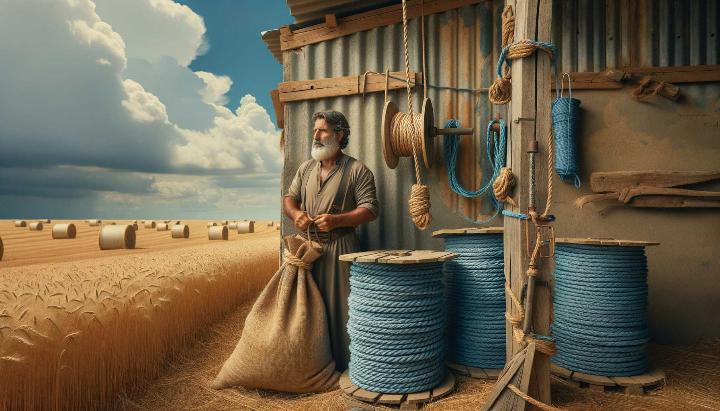Have you ever found yourself in a bind, quite literally, because you chose the wrong rope for the job? Whether you're a seasoned sailor, an adventurous camper, or a DIY enthusiast, selecting the right 3 ply rope can mean the difference between success and frustration. But with countless options available, how do you navigate the complex world of cordage?
Enter iRopes, a leading rope manufacturer with 15 years of experience crafting high-quality ropes in China. With an impressive array of 2,348 cordage options, we've got you covered for every conceivable use - from marine applications to racing sports, industrial needs to safety equipment. Our expertise lies in harnessing the power of strong synthetic fibres like UHMWPE, Technora™, Kevlar™, and Vectran™, combined with innovative coating technologies, to deliver ropes that redefine the standard of "Made in China" quality.
In this comprehensive guide, we'll unravel the mysteries of 3 ply rope, explore the benefits of twisted poly rope, and discover the unique properties of cotton fibre rope. By the end, you'll be equipped with the knowledge to choose the perfect rope for your specific needs, ensuring that whether you're mooring a yacht or crafting a macramé masterpiece, you'll have the right tool for the job.
So, are you ready to learn the ropes? Let's dive in and discover how the right choice can elevate your projects and adventures to new heights!
Understanding the Basics of 3-Ply Rope
When it comes to choosing the right rope for your needs, understanding the basics of 3-ply rope is essential. As someone who's spent years working with various types of cordage, I can tell you that 3-ply rope is a versatile and reliable option for many applications. Let's dive into what makes this type of rope unique and why it might be the perfect choice for your next project.
What is 3-Ply Rope?
3-ply rope, also known as three-strand rope, is exactly what it sounds like - a rope made by twisting three individual strands together. This simple yet effective construction method has been used for centuries, and for good reason. The intertwining of these strands creates a strong, durable rope that can handle a variety of tasks.
Imagine running your fingers along a 3-ply rope - you'd feel the distinct ridges of each strand, giving the rope its characteristic texture. This construction not only provides strength but also makes the rope easy to grip, even when wet.

Applications and Uses of 3-Ply Rope
3-ply rope is incredibly versatile, finding its way into various industries and applications. Here are some common uses:
- Marine applications: From mooring boats to tying down cargo, 3-ply rope is a staple in the maritime world.
- Construction: It's often used for hauling materials or creating temporary barriers on job sites.
- Outdoor adventures: Campers and hikers appreciate its strength for setting up shelters or securing gear.
- Agricultural use: Farmers rely on 3-ply rope for everything from baling hay to leading livestock.
Have you ever wondered why 3-ply rope is preferred in these situations? It's because of its unique combination of strength, flexibility, and ease of handling. Unlike braided ropes, 3-ply ropes are less likely to snag or kink, making them ideal for tasks that require frequent tying and untying.
How to Splice 3-Ply Rope
One of the advantages of 3-ply rope is its ease of splicing. Splicing allows you to join two ropes together or create loops without compromising the rope's strength. Here's a quick guide to creating a basic eye splice:
- Unlay the strands at the end of the rope for about 10-12 times the rope's diameter.
- Form a loop of the desired size, and pass each strand through the lay of the rope in the opposite direction.
- Continue tucking each strand under at least three strands of the main rope.
- Taper the splice by cutting away a portion of each strand after each tuck.
Remember, practice makes perfect when it comes to splicing. Don't get discouraged if your first attempts aren't picture-perfect - even seasoned sailors had to start somewhere!
Always wear gloves when splicing rope to protect your hands, and use a fid or marlinspike to make the process easier and more precise.
Understanding the basics of 3-ply rope is just the beginning. As you explore different materials and applications, you'll discover why this type of rope has stood the test of time. Whether you're a weekend warrior or a professional rigger, 3-ply rope is a versatile tool that deserves a place in your toolkit.
Exploring the Versatility of Twisted Poly Rope
As someone who's spent countless hours working with various types of rope, I can confidently say that twisted poly rope is a game-changer in the world of cordage. Its versatility never ceases to amaze me, and I'm excited to share with you why it's become my go-to choice for so many applications.
Unmatched Strength and Durability in Challenging Environments
One of the first things you'll notice about twisted polypropylene rope is its impressive strength-to-weight ratio. It's remarkably light in your hands, yet it can handle loads that would make other ropes snap under pressure. I remember a time when I was helping a mate secure his boat during a particularly nasty storm. The twisted poly rope we used held fast, while other boats with different ropes struggled against the wind and waves.
The secret lies in its twisted construction. Each twist adds to the rope's overall strength, creating a synergy that's greater than the sum of its parts. This unique structure also contributes to its exceptional durability. I've seen twisted poly ropes withstand harsh conditions that would have frayed or weakened other types of rope in no time.
Did you know? Twisted polypropylene rope is highly resistant to UV radiation, making it an excellent choice for outdoor use. It won't degrade or lose strength when exposed to sunlight, unlike many natural fibre ropes.
From Marine to Construction: Diverse Applications of Twisted Poly Rope
The versatility of twisted poly rope truly shines when you consider its wide range of applications. In marine settings, its buoyant nature is a massive advantage. I've used it for mooring lines, anchor ropes, and even as makeshift life lines in a pinch. The rope floats on water, making it easy to spot and retrieve if it falls overboard.
But don't think twisted poly rope is limited to water-based activities. In construction and engineering projects, it's become an indispensable tool. Its resistance to chemicals and abrasion makes it perfect for temporary barriers or hauling materials on job sites. I've even seen it used in innovative ways, like creating lightweight, durable netting for safety barriers.
In agriculture, twisted poly rope has found a special place in farmers' hearts. From baling hay to creating temporary fencing, its strength and weather resistance make it a reliable choice in all seasons. I once helped a farmer friend rig up a simple pulley system using twisted poly rope to lift heavy feed bags, saving his back and time in the process.

What's your experience with twisted poly rope? Have you found any unique applications that I haven't mentioned? I'd love to hear about them in the comments below. Remember, whether you're tackling a DIY project at home or planning a large-scale industrial operation, twisted poly rope offers a blend of strength, durability, and versatility that's hard to beat.
Unique Properties of Cotton Fiber Rope
As a rope enthusiast who's worked with various materials over the years, I've always had a soft spot for cotton fiber rope. There's something about its natural feel and versatility that keeps drawing me back. Let's dive into what makes this traditional cordage so special and why it might be the perfect choice for your next project.
Physical Characteristics of Cotton Fibers
Cotton fiber rope is a marvel of nature's engineering. At its core, each cotton fiber is composed of cellulose, arranged in a unique twisted ribbon or collapsed tube structure. This microscopic configuration is what gives cotton rope its distinctive properties.
When I first examined cotton fibers under a microscope, I was amazed by their intricate structure. It's this natural architecture that contributes to the rope's remarkable ability to absorb moisture while remaining breathable. In fact, cotton fiber rope can absorb up to 27 times its own weight in water!

But here's a fascinating tidbit: unlike most materials, cotton fiber rope actually gets stronger when wet. It can increase its strength by 10-20% when damp, making it an excellent choice for marine applications where moisture is a constant factor.
Advantages of Cotton Rope in Various Applications
The unique properties of cotton fiber rope make it a versatile choice for a wide range of applications. Here are some of the standout benefits:
- Softness and flexibility: Cotton rope is incredibly gentle on the hands, making it perfect for applications where comfort is key, such as hammocks or pet toys.
- Eco-friendly and biodegradable: As a natural fiber, cotton rope breaks down over time without harming the environment, unlike synthetic alternatives.
- Excellent for knot-tying: The texture of cotton rope provides just the right amount of friction, making knots secure and easy to tie.
- Aesthetic appeal: There's an undeniable charm to cotton rope that makes it popular in decorative applications, from rustic home decor to intricate macramé projects.
I once used cotton rope to create a hanging plant display in my sunroom. Not only did it look fantastic, but it also held up beautifully to the moisture from watering the plants. The rope's natural ability to absorb and release moisture prevented any mold growth, which had been an issue with synthetic ropes I'd tried previously.
When using cotton fiber rope outdoors, remember that it's susceptible to UV damage over time. Consider treating it with a UV-resistant spray or replacing it periodically to maintain its strength and appearance.
While cotton fiber rope may not be as strong as some synthetic options, its unique combination of properties makes it an ideal choice for many applications. From its natural feel to its eco-friendly composition, cotton rope continues to be a favorite among both traditionalists and innovative crafters alike.
Have you ever used cotton fiber rope in a project? I'd love to hear about your experiences and any creative applications you've found for this versatile material. Share your stories in the comments below!
Choosing the Right Rope with iRopes' Expertise
When it comes to selecting the perfect rope for your needs, having expert guidance can make all the difference. That's where iRopes' 15 years of experience in rope manufacturing comes into play. Let me share with you how our expertise can help you navigate the complex world of cordage and find the ideal solution for your specific requirements.
Understanding Rope Types and Their Applications
At iRopes, we've spent years perfecting our craft, and we've learned that no two rope applications are exactly alike. That's why we offer a diverse range of rope types, each with its own unique properties and ideal uses. Let's break down some of the most common types:
- Static ropes: These are perfect for applications where you need minimal stretch, such as rappelling or hauling heavy loads.
- Dynamic ropes: Ideal for activities like rock climbing, where some stretch is necessary to absorb the energy of a fall.
- Nylon ropes: Known for their excellent strength-to-weight ratio and shock-absorbing properties.
- Polyester ropes: Great for marine applications due to their resistance to UV damage and minimal stretch when wet.
I remember a time when a customer came to us looking for a rope for their sailing expedition. By understanding their specific needs - resistance to saltwater, UV protection, and high breaking strength - we were able to recommend a polyester rope that performed flawlessly throughout their journey.

Factors to Consider When Selecting a Rope
Choosing the right rope goes beyond just picking a material. At iRopes, we guide our customers through a comprehensive selection process, considering factors such as:
- Rope length: Too short, and you're left in a bind; too long, and you're dealing with unnecessary bulk and weight.
- Diameter: This affects not only the rope's strength but also its handling characteristics.
- Intended use: Are you using it for marine applications, industrial purposes, or outdoor adventures?
- User skill level: Some ropes require more experience to handle safely and effectively.
- Environmental conditions: Will the rope be exposed to UV rays, chemicals, or extreme temperatures?
Our team of experts is always ready to help you navigate these considerations. We've even developed a handy checklist to ensure you don't overlook any crucial factors when selecting your rope.
Did you know? iRopes offers custom rope solutions tailored to your specific needs. Our team can work with you to create a rope that meets your exact specifications, ensuring optimal performance for your unique application.
At iRopes, we're not just about selling ropes; we're about finding solutions. Our commitment to quality is reflected in our use of high-grade synthetic fibers like UHMWPE, Technora™, Kevlar™, and Vectran™. These materials, combined with our advanced coating options, allow us to create ropes that meet and exceed industry standards.
Have you ever struggled to find the right rope for a specific task? Share your experience in the comments below, and let's discuss how iRopes' expertise could help you overcome similar challenges in the future.
Remember, choosing the right rope is not just about strength or durability; it's about finding the perfect balance of properties that match your unique needs. With iRopes' extensive range of options and our team's deep knowledge, you can rest assured that you'll find the ideal rope for every application.
```htmlSelecting the right 3 ply rope for your specific application is crucial, and iRopes, with its 15 years of expertise, offers an outstanding array of high-quality options. Whether you seek the robust and versatile 3 ply rope, the durable twisted poly rope known for its resistance to UV and chemicals, or the eco-friendly cotton fiber rope prized for its softness and aesthetic appeal, iRopes has you covered. Leveraging strong synthetic fibers like Technora™ and Vectran™, iRopes caters to various industries, including marine and safety, showcasing the excellence of "Made in China" craftsmanship. Explore how iRopes' customization and expert guidance can elevate your rope selection.
Explore iRopes' Tailored Rope Solutions
Above, you'll find our inquiry form. Fill it out to discover more about how iRopes can meet your rope needs with precision and reliability. Let us guide you in choosing the ideal rope for every application, ensuring strength, durability, and performance every time.
```